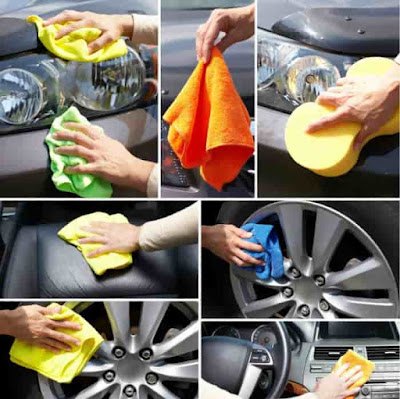If you do not
know these important spring car cleaning tips, your car may not be ready for
the road trips you plan to take. Each spring, take the time to tune up and rev
up your car to make sure it has the ability to help you enjoy the outdoors in
the coming driving season.
The
10 Most Important Spring Car Cleaning Tips You Need to Know, As the sun warms
up, you may feel the need to roll up your sleeves and to tackle the big task of
cleaning and tuning up your car. Getting rid of the winter mess inside and on
the outside of your car is critical. The following are the 10 most important
things you should do:
1. Carpeting and Upholstery: Focus first on the interior carpeting and upholstery. Using a damp towel,
wash down the seats. Get rid of any rock salt debris, mud or dry dirt on the
carpeting using a carpet-cleaning machine, if possible ;
2. The Console: Wash the consoles carefully. Avoid getting electrical connections wet,
but do wipe them down appropriately. Clean out cup holders, too. Use a wet
cloth to get the top of the dashboard, but be careful to dry it thoroughly ;
3. Organize: Clean out the compartments. In your rush to get inside and out of the
cold during the winter, you may have debris, trash or just too much stuff in
the car. Get the compartments cleaned out and organized ;
4. The Windows: Shine the windows. After all that winter driving, the windows will need a
bit of extra attention. Clean the inside and outside using a window cleaner.
Shine them with a dry towel. Do the mirrors of the vehicle in the same way ;
5. The Trunk: Check the trunk of the vehicle next. Clean out the wintertime mess. This
is also a good time to make sure the spare tire is in good repair. Be sure your
emergency kit is in order too. Vacuum the trunk out ;
6. The Exterior Body: Look at the exterior of the car. A good car washing is often in order.
Make sure the first spring car wash is a thorough one that gets the winter
grime out of cracks and under the edges. Use a soft towel and a mild detergent
to wash the vehicle down ;
7. The Wheels: Pay some extra attention to the wheels. Remove the hubcaps and wash them
down. Scrub the tires and wheel wells thoroughly. This is also a good time to
check the tire pressure and to tighten up any loose lug nuts ;
8. Under the Hood: Look under the hood next. Leaves, debris and even dirt can get into the
engine area. In some cases, just wiping down the edges is enough. In other
cases, you may need to consider having the engine wiped off or professionally
cleaned ;
9. Waxing: Waxing the exterior of the car is a good idea, as long as you do so out
of direct sunlight. Choose a spray or liquid wax for the best results. If you
are using a new product, test it on a hidden portion of the car's body to
ensure it works properly ;
10. Replace Wipers: After a harsh winter, many vehicles require new windshield wipers. Having
wipers in good working order is necessary, especially during intense spring
showers.
Take an afternoon to detail clean the car.
Doing so will make sure the vehicle is in the best condition possible for the
upcoming summer months.
Maintenance Considerations
While these ten tips for spring cleaning
are important, springtime also brings the need for maintenance and tune ups.
Focus on the following areas:
-
Get the oil changed as needed ;
-
Tune up the engine to ensure it is working at its best. This includes
having belts checked ;
-
Have the air conditioning tested ;
-
Be sure all lighting systems, both on the exterior and interior of the car,
are working properly ;
-
Replace tires if they no longer hold air properly.
These tips will enhance the function of
your vehicle. These, along with the spring car cleaning tips above, will ensure
your car is working and looking its best throughout the spring and well beyond.





